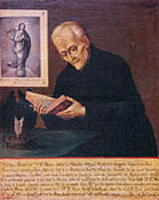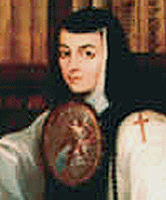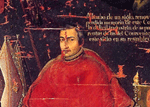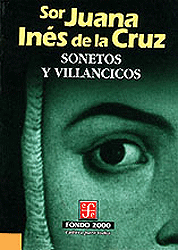Sor Juana Inés de la Cruz (1648-1695; SJIC)
1648 (November
12: Octavio Paz's theory about her birth date) Juana de Asbaje y Ramírez was
born in San Miguel Nepantla, México (
In order to visualize where she lived as a child, see the following images: |
|
|---|
1654 At
six years old, she learned to read at a school called "Amiga" (girl
friend) in Amecameca (near
1656 Her
beloved maternal grandfather, Pedro Ramírez de Santillana died. Upon his death she was sent to live in Mexico City with an aunt.
1656-61 Juana
de Asbaje y Ramírez lived an aunt and, later, either with unknown relatives or in the court of the
viceroy.
1658 Juana
de Asbaje y Ramírez composed a eulogy (una
loa) for the Holy Eucharist (el Santo
1661 Juana de Asbaje y Ramírez moved
permanently to Mexico City.
1664 She arrived at the Mexican vice-regal court of the marqués (marquis) Mancera and his wife, the marquesa. The marquesa would become Juana's patron, and Juana would refer to the marquesa in her works as "Laura". The marqués de Mancera's actual name was Antonio Sebastián de Toledo. He was the viceroy from 1664 to 1673.
This
viceroy's name was don Sebastián de Toledo. He was viceroy from 1664 to 1674.
Juana
de Asbaje y Ramírez became a lady-in-waiting (una dama) of the marquesa.
1665 Juana
de Asbaje y Ramírez wrote a poem about the death of the king of
1666 She
became a novitiate (una novicia) in
the convent of the Discalced Carmelites (las
Carmelitas Descalzas); after three months in this convent of barefoot nuns,
Juana changed her mind and left the convent.
1668 Viceroy
Mancera gave Juana a test to determine if Juana's knowledge and intelligence
were legitimate because she had shown signs of extraordinary talent. The test
results amazed him and everyone else.
1669 Juana
became a nun in the religious Order of San Jerónimo, and she signed her last
will and testament in and for this religious order. (The Orden de San Jerónimo
was less severe and less strict than the Carmelite order she tried out first.)
Juana de Asbaje y Ramírez changed
names to Sor Juana Inés de la Cruz
(SJIC). She lived in the
convent of
1674-1680 A
new viceroy ruled the Virreinato de Nueva
España (Viceroyalty of New Spain): Fr. Payo Enríquez de Rivera. He was
simultaneously viceroy and Archbishop of New Spain.
SJIC
wrote three baroque sonnets on the death of the virreina (the wife of her first viceroy, the Marqués de Mancera). She called this woman "Laura."
1676-1691 SJIC
wrote fifteen villancicos (Christmas
carols), which were commissioned by various people in the court and in
convents.
1680-1686 A new viceroy arrived: el marqués de la Laguna and la marquesa, his wife. The viceroy's name was don Tomás Antonio de la Cerda y Aragón, and his wife was María Luisa Manrique de Lara. Both came from the highest Spanish aristocracy, and both favored and sponsored SJIC.
SJIC
wrote love poems (poesía erotica) and
plays (comedias) for her protectress,
la marquesa.
SJIC published her long
allegorical poem, "Neptuno alegórico".
1680-1690 SJIC
wrote poems and plays for the court, for her own intellectual pleasure and to
suppress and sublimate her own emotions and psyche.
1681-1690 SJIC
wrote a letter to P. Antonio Núñez de Miranda, who was her father confessor from
1671-1690. She accused him of intolerance and she dismissed him (rejected him)
as her confessor in 1690. (Nuns had obtained the right to dismiss a confessor (change
confessor on their own) as one of the reforms of the Council of Trent (el
Concilio de
 |
1685 SJIC
wrote the masterpiece of her poetry, "el Primero Sueño" (First
Dream). This long philosophical, metaphysical baroque poem was published in
1692. To read this poem on-line in Spanish, click on this URL: => El Primero Sueño.
1686-1688 A
new virrey and virreina arrived: the Count of Monclova (el conde de
1686 SJIC
wrote a poem celebrating the viceroy's wife (la virreina), whom she calls by the cryptic name of
"Lysi".
1688-1696 A
new viceroy ruled over New Spain, the Count of Galve (el conde de Galve). His name was Gaspar de Sandoval Silva y
The
first edition of Volume I one SJIC's works was published in
1690 SJIC's
enemy arrived in
SJIC's
auto sacramental (one-act religious
play), El divino Narciso (Divine
Narcissus, allegory for Christ), was published.
SJIC's
major theological essay, "Carta atenagórica", was
published without her knowledge. This is a critical essay of SJIC's in which
she comments on a published sermon. The Carta
atenagórica was printed with a prologue by a certain Sor Filotea de la
Cruz, which was, in fact, the pseudonym (pen name) of Fr. Manuel Fernández de
Santa Cruz, who was the bishop of Puebla (a major city SE of Mexico City) and
who belonged to the male branch of Sor Juana's religious order, the Orden de
San Jerónimo. Bishop Fernández had not obtained Sor Juana's permission to
publish her essay (the Carta);
furthermore, the bishop chose the title for the publication. In her essay, Sor
Juana attacks a sermon by the highly respected and influential Portuguese
Jesuit theologian Vieyra from early in the seventeenth century. Within a couple
of years, the controversy caused by Sor Juana's Carta caused her to become disgraced, censured, and ordered to
cease all humanistic activities including, even, just reading.
To read this essay in Spanish, click following URL: => Carta atenagórica.
The
Bishop of Puebla prefaces the Carta
with a letter, which he styles as "friendly advice" to Sor Juana by
lightly threatening her for the mistakes she makes in the content of her essay;
he also threatens her by saying that her ideas put her eternal salvation in
grave danger; and he adds that she should apply herself only to religious and
spiritual matters—not scholarship, which, for him, is reserved
exclusively for men. He signs his "letter" as Sor Filotea de la Cruz,
pretending to be a nun (Sister Lover of God of the Cross).
1691 SJIC writes her response to Sor
Filotea's prologue: "La respuesta a Sor Filotea de la Cruz"
(Answer to Sor Filotea…). This
essay is both a major autobiography and a brilliant legal brief, as it were, in
defense of her right as a woman to think, study, write, and publish her
thoughts.
(November
25) SJIC's last villancicos
(Christmas carols) are in the Cathedral of Oaxaca (southern
To
read this essay in Spanish, click following URL: => La respuesta.
For
homework/study questions on the "Answer"/"La respuesta",
see: => "The Answer" Study Questions.
1692 The
first edition of Volume II of SJIC's works is published in
SJIC's
"Primero Sueño" is
published (see 1685 above).
The
Bishop of Puebla (of the San Jerónimo order), who is opposed to the
Archbishop's fanatical Jesuit confessor, Fr. Núñez de Miranda (see: 1690
above), orders SJIC's response essay, "La
respuesta…", published, thereby sealing the condemnation of Sor
Juana by higher religious authorities.
1693 Fr.
Núñez de Miranda continues having powerful influence throughout the Viceroy's
court in
Fr.
Núñez de Miranda orders her confessor to have everything SJIC had in her convent cell removed (library, scientific
instruments, musical instruments, music scores, manuscripts, writing
implements, art works, etc.) and he then gives all of it to Archbishop Aguiar y Seijas, who uses and stores all of it.
1694 SJIC
signs a declaration of faith with her own blood; she repents about everything
she had done and accomplished in her life; and she discontinued studying
theology and every non-religious activity.
1695 (April
17) Sor Juana Inés de la Cruz dies at 4:00 a.m. during an epidemic of
undetermined nature that was ravaging Mexico City that winter and spring.
1700 The
posthumous publication of Volume III or SJIC's works was published: Fama y Obras pósthumas including the
first publication in
Sor
Juana Inés de la Cruz is probably the foremost woman writer in the history of
Latin American humanities, and she is justly renowned as one of the finest
writers in the history of humanistic letters. She wrote entirely in the baroque
manner, and her works continue to have universal appeal. In addition, she is
one of the world's first feminists more or less in the sense that this term and
liberation movement came to be known and styled in the late twentieth century.
The breadth and depth of her talents were extraordinary. She excelled in
literature (especially the prose essay, poetry and drama), music (singing,
composition, and performer on several instruments), philosophy, science,
languages, metaphysics, and theology. Sor Juana's life gives witness both to
immense success and terrible tragedy. Her achievements in many fields of the
humanities are lasting contributions to the patrimony of humankind's great
productions throughout the ages. Her woman's voice, crying out for the right of
self-expression and self-realization, remains an elegant call for truth and
justice and human right for women, and, indeed, therefore, for all humans. The
social forces that silenced her at the end of her life and that, no doubt,
contributed to her relatively premature death, are nothing less than tragic.
Sor Juana Inés de la Cruz was almost without a doubt the most intelligent and
most accomplished person (man or woman) of the entire Colonial period in the
Viceroyalty of New Spain.
To
sum up, Sor Juana lived during the Latin American Colonial period of the
Spanish Viceroyalty (el virreinato)
of
(Note
on Fr. Athanasius Kircher: he was a 17th century German Jesuit
intellectual who has been compared to Leonardo da Vinci for the breadth and
inventiveness of his scholarly persuits. He worked famously in fields as varied
as Asian culture, geology, medicine (microbes, diseases, etc.), Egyptian
hierioglyphics. He published more than 40 books. He is less known than he
should be because his fame was eclipsed by the French rationalist René
Descartes.)
To
read and study one of the most famous of Sor Juana's sonnets, click on the
following image or on the sonnet link button below:









